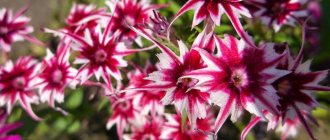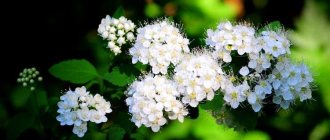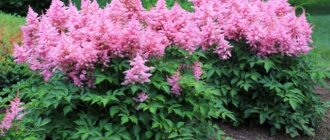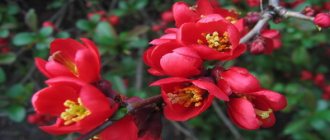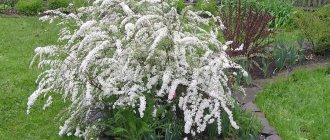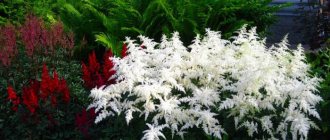Author: Elena N. https://floristics.info/ru/index.php?option=com_contact&view=contact&id=19 Category: Garden plants Published: February 19, 2019Last edits: November 29, 2020
- Reproduction by layering
Japanese spirea (lat. Spiraea japonica) is a species of ornamental shrubs of the Rosaceae family, native to China and Japan. In our latitudes, this decorative plant throughout the season has been known for a long time - since 1870. It is used to create borders, hedges and long-flowering groups; low-growing forms are grown in rockeries, rock gardens, mixborders, and they are also grown as a ground cover plant.
Planting and caring for Japanese spirea
- Flowering: in July-August for one and a half months.
- Planting: best in early spring, before the sap begins to flow, although it is also possible in October.
- Lighting: in the morning - direct sun, then - bright diffused light.
- Soil: fertile and drained.
- Watering: after planting - frequent and plentiful; after rooting, water 2 times a month. Water consumption for an adult bush is up to 15 liters.
- Top dressing: in the spring the tree trunk circle is mulched with compost or peat, and in the fall the mulch is incorporated into the soil. Mineral fertilizers are applied immediately after pruning, and in mid-summer the tree trunk area is watered with an infusion of fermented mullein with the addition of superphosphate.
- Pruning: sanitary and formative – in May. Anti-aging pruning is also carried out in the spring at the age of four.
- Reproduction: species plants - by seeds, varietal and hybrid plants - by dividing the bush, cuttings and layering.
- Pests: aphids, spider mites, roseate leaf rollers.
- Diseases: not affected.
Read more about growing Japanese spirea below.
Diseases and pests
Japanese spirea bushes usually exhibit high disease resistance and rarely suffer from pests. In hot and dry weather, spider mites may become more active, and sometimes young shoots and leaves may suffer from an invasion of aphids or leaf roller caterpillars.
You should first fight them using traditional methods, spraying the bushes with a solution of tobacco dust, or infusions of garlic and tomato tops. As a last resort, acaricidal drugs are used against ticks, and insecticides against aphids and caterpillars.
Botanical description
Japanese spirea is a beautiful deciduous shrub up to 2 m in height and in diameter with tomentose-pubescent young shoots that become bare with age, green on the upper side and bluish on the lower oblong-ovate leaves, which when blooming have a reddish tint, and in the fall become variegated color in red and yellow tones. The length of the leaves, arranged alternately and serrated along the edges, is from 2.5 to 7.5 cm. The pink-red flowers of Japanese spirea are collected in complex terminal corymbose-paniculate inflorescences. The flowering of spirea lasts about one and a half months. Seeds up to 2.5 mm long are in small shiny capsules.
Main types of spirea
In accordance with the description of spirea, the shrub is divided into classifications depending on flowering time. The landing characteristics, as well as the appearance that can be seen in the photo, depend on this.
- Spring flowering shrubs. They produce flowers in late spring or early summer. The flowers are very beautiful, usually colored in different variations of white.
- Summer flowering. Their inflorescences form on the tops of young shoots. The flowers are usually pink, but can also be pinkish-red or just red.
Planting Japanese spirea
When to plant
Like any garden shrub, spirea is planted in early spring or after leaf fall, but summer-flowering species of spirea, which include Japanese spirea, are best planted in early spring, but it is very important to plant before the buds begin to swell on the trees.
Growing spirea in the garden - planting and care
When choosing a place to plant Japanese spirea, you should know that this plant is very light-loving, and although three to four hours of direct sun a day is enough for it, the more light there is, the more beautiful the spirea will be. The Japanese spirea shrub is undemanding in terms of soil composition, but in fertile soil it grows better and blooms more luxuriantly.
- Catharanthus: growing from seeds, types and varieties
How to plant
If you purchased seedlings with an open root system, carefully inspect it: it should not be dry. The shoots of the seedling must be flexible and the buds alive. Remove dry or rotten roots with pruning shears, and shorten healthy ones to 25-30 cm. Before planting, seedlings with a closed root system are watered generously and removed from the container, and if the earthen ball has dried out, place the root system in a bucket of water for an hour or two.
When planning planting, keep in mind that the roots of Japanese spirea grow strongly, so the distance between seedlings should be at least 50 cm. A hole for spirea is dug with steep walls, and its volume should be at least a third larger than the root system of the plant. Before planting, the hole should stand for at least two days, then a drainage layer, for example, stones or broken bricks, is placed on its bottom, then the hole is filled with garden soil mixed with river sand and peat in a 2:1:1 ratio. The roots of the seedling are lowered into the hole, carefully straightened and the remaining space is filled with soil mixture. The root collar of the spirea should be flush with the surface. After planting, the soil around the seedling is compacted and watered with two buckets of water.
Japanese spirea care
Japanese spirea in the spring, immediately after planting, needs frequent and abundant watering. When the plant is established, watering can be reduced to twice a month, spending up to 15 liters of water on each adult bush. Good watering of spirea is especially important during drought and after pruning. Having moistened the soil, it is advisable to loosen the soil in the tree trunk circle, while simultaneously removing weeds.
Every spring, the surface of the soil around the spirea is mulched with a mixture of peat, compost and crushed bark, and in the fall this mulch is embedded in the ground. As for fertilizing, it is very important to add fertilizer to the soil immediately after pruning. Japanese spirea responds well to the introduction of a liquid infusion of fermented mullein into the tree trunk in mid-summer with the addition of 10 g of superphosphate for every 10 liters of infusion.
Pruning of Japanese spirea is carried out in May to give it the correct shape, as well as for sanitary and rejuvenating purposes. Dry, diseased, frozen, small, weak and thickening branches and shoots are cut out, and healthy ones are shortened to large buds. If you need to rejuvenate the bush, do not be afraid to overdo it: heavy pruning stimulates the formation of a large number of healthy young shoots, and if the spirea is not rejuvenated, then the old shoots will begin to droop to the ground over time, and the top of the bush will dry out. The first rejuvenating pruning of Japanese spirea is recommended to be carried out after four years, cutting off the shoots at a height of no more than 30 cm from the ground.
The Japanese spirea bush is very resistant to diseases and pests, but sometimes suffers from aphids, spider mites and roseate leaf rollers. Leaf roller caterpillars, which appear in late spring, damage more than half of the leaves, gnawing holes in them. Aphids, feeding on cell sap, suck it out of the leaves, peduncles and young shoots of spirea. Spider mites are the most dangerous sucking pests, especially active in dry weather. Aphids and mites are destroyed with acaricidal preparations, and leaf-eating pests are destroyed with an insecticide solution. And do not forget that only creating the necessary conditions for the life of a plant and timely care for it can save any plant from diseases and pests.
- How to grow Buddleia Davida seedlings from seeds: sowing and picking
As you can see, planting Japanese spirea and caring for it is not at all burdensome.
Biological features
Japanese spirea, resistant to many unfavorable conditions, is successfully grown in almost all regions of our country, from the southern borders to the Arctic. It can grow even without the presence of fertile soil, fertilizing, watering and shelter for the winter.
Decoratively trimmed Japanese spirea bush
Japanese spirea in the living room decor
Japanese spirea is usually watered only during the first year of its life. It is also not necessary to trim it. The height of the plant bushes depends on the variety and varies in the range of 20-150 cm. The crown of this type of spirea is hemispherical without “bare legs,” sometimes thick, and sometimes a little “disheveled.”
Spiraea "Grefsheim"
Japanese spirea in fireplace decor
Reproduction of Japanese spirea
Japanese spirea is propagated by generative and vegetative methods, however, for hybrid forms and plant varieties, the seed method is not suitable, and for other varieties, cuttings and propagation of spirea by layering are preferable, since these methods allow you to achieve reliable and quick results with minimal time and labor.
Reproduction by layering
In early spring, the lower shoot or root shoot of the spirea is bent to the ground, placed in a trench, secured in this position, leaving the top of the shoot above the surface. This method will allow you to get a single seedling with a well-developed root system by autumn. If you want to get more seedlings, then the top of the shoot should be pinched, and then young shoots will begin to grow from the side buds. In the fall, such cuttings are dug up, divided into parts according to the number of regrown shoots and planted in a permanent place.
Propagation by cuttings
Cuttings are the most productive method of propagation, since the survival rate of cuttings is 70% even without the use of growth regulators. The substrate for planting cuttings is prepared from high-moor peat (1 part) and sand (1 or 2 parts). Experienced gardeners prefer to root cuttings in September or October: they select the strongest shoots from the bush, cut them into pieces, each of which should have 4-5 leaves, and the bottom leaf is removed, leaving only the petiole, and the rest are shortened by half. Then the cuttings are soaked in water for 2-3 hours, and before planting, their lower sections are dusted with a root stimulator.
The cuttings are planted at an angle of 45º, immersing them 2 cm into the substrate, after which the cuttings are covered with a transparent cap and placed in the shade. Caring for cuttings during rooting consists of regular watering and spraying. With the onset of cold weather, the cuttings are dug in, covered with leaves on top and covered with an inverted wooden box. In spring or early summer, cuttings are planted in a school for growing, and in the fall they can be planted in a permanent place.
Growing from seeds
If you are not in a hurry and are not afraid of difficulties, then you should try to grow Japanese spirea from seeds. The seeds of this plant do not need stratification. They can be sown in spring or autumn without any preparation. The substrate for sowing needs approximately the following composition: 4 parts non-acidic peat and 1 part vermiculite. A box or container is used as a container. The seeds are sown on the surface of the substrate without covering them, after which the container is covered with film or glass and placed in the shade of the garden on the western or eastern side. As soon as the shoots appear, the covering is removed, and when the seedlings reach a height of 2 cm, they are picked based on color - by this time it will already be distinguishable. When picking, long roots are pinched by one third and planted in a larger container at a distance of 5-6 cm from each other. The seedlings are kept in the shade of deciduous trees, not forgetting to water them, in the fall they are transplanted to the school bed, and next year they can be planted in a permanent place.
Dividing the bush
You can propagate spirea by dividing the bush throughout the growing season, but if you do this in the summer, you need cloudy weather to last for at least a week after planting the divisions. The best time for the procedure is August or early September, when the soil is well warmed up and the air is already cool.
- Gentian: growing and care in the garden, types and varieties
The spirea bush is dug up, capturing about 60% of the crown projection. It’s okay if you have to cut off some of the roots. Wash the roots from the ground, straighten them because they are very twisted, and divide into several parts so that each has at least 2-3 strong shoots and a decent root lobe. Shorten the long cord-like roots, treat the cuts with crushed coal and plant the cuttings in pre-prepared holes. After planting, you need to water the spirea every other day if the weather is sunny, and in cloudy weather - at least once a week.
Varieties of Japanese spirea
Japanese spirea has many garden forms and varieties. The most popular of them are:
- Alpina is a low-growing, densely branched shrub with almost round, densely pubescent striped shoots, dark green leaves above and bluish below, and light pink flowers;
- Japanese spirea Little Princess is a shrub up to 60 cm high with a crown up to 120 cm in diameter. The leaves of this variety are elliptical, dark green, the flowers are red-pink, collected in corymbs with a diameter of 3-4 cm;
- Japanese spirea Shirobana is also a low chameleon shrub with narrow-lanceolate dark green leaves and flowers, the color of which varies from white to red and pink;
- Japanese spirea Microphylla reaches a height of 130 and a diameter of 150 cm. It has pink flowers and large swollen wrinkled leaves up to 20 cm long and up to 10 cm wide. When they bloom, they are purple-red, green in summer, and golden-yellow in autumn;
- Japanese spirea Fairlight - bushes about 60 cm high with orange-red young leaves that gradually become orange-yellow and then pale green. The flowers are deep pink;
- Japanese spirea Goldflame is a shrub about 80 cm high with a dense crown consisting of orange-yellow leaves, which gradually become bright yellow, then yellow-green, and in autumn - copper-orange. The flowers of this variety are small, pink-red;
- Japanese spirea Golden Princess - a shrub about 1 m high with bright yellow leaves and pink flowers;
- Japanese spirea Gold Mount is a small Japanese spirea, only 25 cm high, with bright yellow-golden foliage and pink flowers;
- Candlelight - the height of the Japanese spirea of this variety is also small, only half a meter. It is a compact bush with pink flowers and creamy yellow leaves that become brighter with age;
- Japanese spirea Crispa - the height of this variety is 50-60 cm, the leaves are wavy, reddish when they appear, then light green, and in the fall they turn orange-bronze or scarlet. Flowers of a delicate lilac-pink hue;
- Japanese spirea Darts Red - the shape of the bush of this variety resembles Little Princess, but the buds of Darts Red are pink and the flowers have an intense purple color;
- Japanese spirea Golden Carpet - a bush only 20 cm high and 38 cm wide with smooth golden leaves and a few greenish-pink flowers;
- Spiraea japonica Jenpei (Genpei) is a variety 60-80 cm high and about 1 m wide with reddish-brown shoots and dark green leaves. At the same time, white, pink and red flowers open on the bush;
- Japanese spirea Frobelli - a bush from 80 to 120 cm high with a spherical crown, erect branches, rich crimson inflorescences and purple leaves in spring and autumn, which turn green in summer;
- Japanese spirea Dwarf is a slow-growing dwarf shrub about 30 cm high with a rounded crown. The leaves of the plant are small, green, and orange in autumn. The pink flowers form flat corymbs;
- Japanese spirea Albiflora is also a slow-growing dwarf plant with a dense rounded crown, reaching a diameter of 80 to 150 cm. The leaves are light green, yellow in autumn. The flowers are small, white;
- Japanese spirea Anthony Waterer - a bush up to 80 cm high with pink-purple-ruby flowers and reddish light green leaves when young;
- Japanese spirea Magic Carpet is a creeping shrub with a dense cushion-shaped crown. The bright red leaves gradually turn orange to yellow. The flowers are pink with a purple tint.
Also popular in cultivation are the varieties of Japanese spirea Ruberrima, Nana, Bullata, Neon Flash, Double Play Artist, Pink Parasol, Green and Gold, Manon, Golden Elf, Sandrop, Pink and Gold, Double Play Big Bang, Double Play Gold and others.
Early varieties blooming in spring
Arguta (sharp-toothed)
Early spirea (Spiraea × arguta) or arguta spirea blooms in April, sometimes flowering continues until early May. It grows up to 1.5-2 m. It has a wide crown, the shoots hang picturesquely. White inflorescences consist of densely arranged flowers.
It can freeze in severe (or snowless) winters, so it is recommended to cover it in late autumn. Suitable for creating free hedges. It is often planted near fences, in shrub compositions.
Spiraea arguta, photo
Nippon
Spiraea nipponica Maxim - Nippon spirea grows up to 1.5 m. The bush is about 2 meters wide. Blooms profusely from May to June - white flowers almost cover the stems. The species is frost resistant.
Spiraea niiponica
| Name and description of the variety | Photo |
| "Snowmound". A beautiful shrub with a dense crown. The dark green leaves contrast wonderfully with the flowers that appear in June. Small flowers, collected in inflorescences, are located along the entire length of last year's shoots. An additional advantage is low requirements. The variety is recommended for planting in public places, in gardens, dachas, as a tapeworm or for group plantings, and is intended for creating natural hedges. Height: 1.5 meters. |
plum-leaved
Spiraea prunifolia - plum-leaved spirea grows up to 2 meters, has thin curved shoots covered with green shiny leaves. The leaves turn orange in the fall. It blooms in May-June with white flowers. It is better to plant it in a protected place, because in severe winters it may freeze. Before the onset of winter, the shrub should be covered, since it is less frost-resistant compared to other species. Requires a sunny, warm position. Recommended for creating shrub combinations.
Spiraea plumifolia, photo
Wangutta
Spiraea × vanhouttei – Spiraea Vanhouttei forms magnificent bushes reaching 2.5 meters. Blooms in May-June. Flowers remain on the bush for a relatively long time. Resistant to frost.
The flowers are collected in large white inflorescences; they do not produce seeds. Spiraea Vangutta is usually used in gardens and parks to create unedged hedges. The plant has no special soil requirements. Preferred position: sunny, partial shade. The shrub is ideal for parks and gardens. Spiraea Wangutta is planted next to the wall of the house, on the lawn, along the fence. The shrub looks beautiful in a composition with jasmine and viburnum blooming at the same time.
Spiraea Vanguta, photo
Gray
Spiraea × cinerea – gray spirea grows up to 2 meters in height, with drooping shoots. The leaves are gray-green in spring and summer, yellow in autumn. It blooms in April before the leaves appear, the inflorescences are white. Resistant to frost.
Beautiful flowers, a showy crown and easy growing are good enough reasons to plant this shrub in your garden. Good resistance to pruning allows the shrub to be used as a hedge. Blooming gray spirea creates a romantic impression.
Spiraea gray - interesting varieties
| Name and description of the variety | Photo |
| The Grefsheim variety looks great in gardens, creating wide shrubs with a large number of arched thin shoots. It is worth growing it as a tapeworm in a visible place. Looks great against the backdrop of large shrubs and trees. | |
| " Graciosa" White, densely arranged flowers completely cover the bush, reaching a height of 1-1.2 meters. Flowers cover the entire curved, last year's shoot. Blooms in April-May. |
Gorodchataya
Spiraea crenata L. is a crenate species found mainly in central and southern Europe, especially in the Balkans. This shrubby plant, reaching a height of 1 meter, forms a series of raised shoots that gradually hang to the ground under its own weight. In spring, the shrub looks beautiful when the shoots are densely covered with small white flowers. For good growth, the shrub requires medium-fertile, moderately moist soil.
The plant is resistant to periodic drought, but it needs to be watered, especially during prolonged heat. The species combines with other varieties of spirea and shrubs with weaker growth. Too large bushes growing close in close company can drown out the crenate spirea. Frost resistance allows the plant to be planted in cold regions. Can be grown in containers.
Spiraea crenate, photo
Thunberg
Spiraea thunbergii is a species rarely found in gardens. In recent years, the emergence of several attractive varieties offers hope of changing this state of affairs.
One of the most interesting varieties "Fujino Pink" is a bush with raised shoots, forming oval bushes, blooming profusely with white or slightly pink large flowers. Flowers are arranged in bunches of 3-5 pieces. The slightly pink shrub attracts attention. It has no special soil requirements and is resistant to long periods of drought. In the garden it is better to place it in a sunny place - this will increase the number of flowers.
In warm regions, you can not pay attention to the position of the shrub; in colder regions, it is worth planting it in places protected from cold winter winds. The frost resistance of this species is much less than that of Japanese spirea. In the spring you can feed the shrub, to which it will respond with lush growth - light pink flowers will bloom on these growths next year.
Spiraea Thunberg, photo
oak leaf
Spiraea chamaedryfolia is a low shrub with a very interesting, attractive crown, up to 1.5 meters high. The stems are angular, zigzag, curved towards the ground, giving it a characteristic, wide and irregular shape. Naturally grows in Southeast Europe, Siberia, Central Asia. The shrub has beautiful, oval or ovate, green leaves, deeply serrated at the edges. The leaves are slightly pubescent underneath.
At the end of May, numerous white flowers appear on the bush, formed into dense convex inflorescences located on the tops of the side shoots. The stamens are much longer than the petals, giving the inflorescences a fluffy effect. The plant, grown in good conditions, often repeats flowering in July-August. This is an undemanding shrub; it needs ordinary, average garden soil, moderately moist. Prefers sunny or semi-shaded positions. Resistant to frost and dirt. This is a fast growing plant.
Spiraea oakleaf, photo
Japanese spirea in landscape design
Japanese spirea is the most common and sought-after species of the genus in landscape design. The main reason for this is that the plant remains decorative throughout the growing season. In addition, Japanese spirea is unpretentious, loyal to other plants, tolerates pruning well and is suitable for creating various kinds of compositions. Japanese spirea is often used to line a green hedge of lilac or mock orange. The variety of garden forms of Japanese spirea allows you to find a shrub that will be ideal for decorating a garden or summer cottage.
Low-growing miniature varieties of Japanese spirea are used to create rockeries, in which plants with different flowering periods are often combined and, due to this, unique compositions are built for zoning space. Spiraea is also grown as borders and hedges, and in mixborders it perfectly coexists with deutia, scumpia, turf and dahlias, complementing and emphasizing their beauty. Japanese spirea looks impressive in combination with coniferous plants, such as thuja, spruce, juniper or pine.
general characteristics
Spirea, which easily adapts to the Russian climate, is grown in many regions of the Russian Federation. The genus Spiraea includes about 90 species of this plant. And thanks to the work of breeders, new interesting varieties are constantly emerging.
Japanese spirea blooming
Japanese spirea in the living room decor
The most popular among landscape designers is the Japanese spirea, in the scientific world called Spiraea japonica and which arrived in Russia from China and Japan. Many gardeners love it very much for its long and luxurious flowering.
Japanese spirea in the garden decor of a private house
Japanese spirea in decorating the courtyard of a house
Its elliptical leaves have an interesting feature. In the spring, when they bloom, they become reddish-brown in color, with the arrival of summer they turn green, and in the fall they begin to acquire a reddish tint again. But today, breeders have already obtained varieties that do not change the color of their foliage from spring to autumn.
Japanese spirea exceeds all representatives of its genus in flowering time. Starting from mid-June, pleasantly smelling caps of flowers appear on it, presenting a spectacular spectacle that can be admired until autumn.
Japanese spirea in the design of a summer cottage
Spiraea "Golden Princess"
